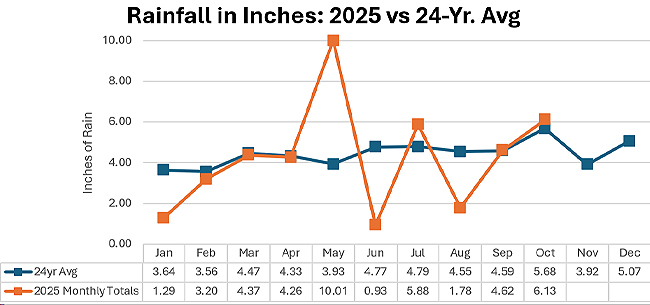Public Notice: As of November 7, 2025, the Executive Office of Energy and Environmental Affairs declared the Central Region of Massachusetts a level 1 drought status.
Current Reservoir Capacity
As of: 11/7/2025
60.6%
Current Drought Status
Level 1 Drought
STATUS KEY:
- No Drought
- Level 1
- Level 2
- Level 3
- Level 4
Rainfall
Monthly rainfall totals for September and October have returned to average allowing groundwater and surface water levels to rebound across the region from what was a relatively dry summer.

Conservation
In current conditions, even average daily water usage in combination with a lack of rainfall leads to depletion of the water supply. Conserving water doesn't just mean using less water, it also means using water more efficiently and YOU can make a difference. For more tips on water conservation, visit our Water Conservation Page.
Water Use Restrictions
Level 1- Mild Drought Water Restrictions Applicable to All Water Users
All nonessential outdoor water uses are restricted to no more than one day per week, before 9 a.m. and after 5 p.m., except that watering of ornamentals and flower gardens with drip irrigation, hand-held hose, or watering cans may be permitted.
Residential, commercial, and industrial water users will be restricted to the following schedule:
- Nonessential outdoor watering will be permitted on Wednesdays before 9 a.m. and after 5 p.m.
Level 1 - Mild Drought Water Restrictions - Golf Course Operation
- Irrigation of fairways shall be reduced to 80% of normal, irrigation of roughs shall be reduced to 50% of normal, and there shall be no irrigation of landscaping and ornamentals.
Contact Information
Address
Water and Sewer Operations
20 East Worcester Street
Worcester, MA 01604
Contact
Phone: 508-929-1300
Fax: 508-799-1448
Email Us
![]()
![]()
![]()
Hours
Monday - Friday
9 a.m. - 4 p.m.

